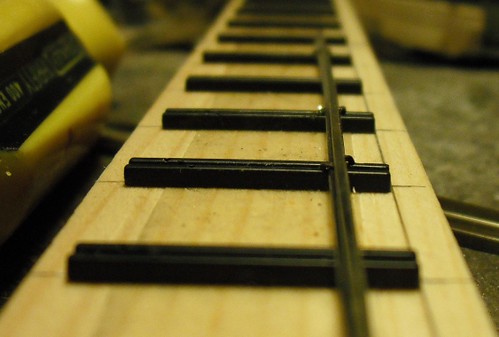 All the O14 sleepers have holes moulded in them for the spikes intended to hold the rail. The theory is that you place the rail between the holes and push a spike down each side so it grips the base securely. This is how the prototype does it in many parts of the world - notably in early American railroads - as well as many narrow gauge lines.
All the O14 sleepers have holes moulded in them for the spikes intended to hold the rail. The theory is that you place the rail between the holes and push a spike down each side so it grips the base securely. This is how the prototype does it in many parts of the world - notably in early American railroads - as well as many narrow gauge lines.Theory is fine but give it to someone as cack-handed as me and bad things can happen.
First up, the head of the rail is 0.9mm wide and the base 1.7mm. By my calculations that leaves 0.6mm of visible base if you look from the top of the rail. Therefore the horizontal gripping bit of the spike needs to be 0.5mm wide. This assumes vertical spiking which the moulded holes encourage.
The supplied spikes have to be trimmed back according to the instructions so I diligently snipped them back a bit (before you say it, Peco spikes are no better as the top is the same and the spike a lot longer) although without any great precision. I'm not using my best snips for this and only the big 'uns would go through the metal anyway.
Then I held the rail in place and pushed the spikes in with some small pliers. They are good and sharp puncturing the sleeper and wood without any great difficulty. Sadly without any great accuracy either as the photo shows:

Narrow gauge track might be a bit wobbly on the prototype but if this carries on, the gauge will be all over the place. Never mind, this is a learning expereince and I have another idea.
1 comment:
I alwys cut PECO spikes and pins back they're far too bendy otherwise.
Post a Comment